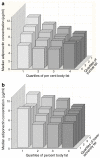Adipose tissue mass and location affect circulating adiponectin levels
- PMID: 21779869
- PMCID: PMC4090928
- DOI: 10.1007/s00125-011-2252-z
Adipose tissue mass and location affect circulating adiponectin levels
Abstract
Aims/hypothesis: Plasma levels of adiponectin are inversely associated with body mass. We hypothesised that adipose tissue distribution and body composition influences adiponectin levels.
Methods: We assessed plasma adiponectin concentrations and dual-energy X-ray absorptiometry (DEXA) measurements of body composition among 2,820 participants from the Dallas Heart Study.
Results: Among both women and men, adiponectin levels were higher in whites than in either Hispanics or African-Americans (for women: median 9.99 μg/ml [25th,75th percentile 7.11, 13.77] vs 7.56 μg/ml [5.05, 9.98] vs 6.39 μg/ml [4.37, 9.41], respectively, p < 0.0001; for men: 6.43 μg/ml [4.66, 9.19] vs 5.55 μg/ml [3.64, 7.50] vs 5.03 μg/ml [3.39, 7.28], p < 0.0001). In univariate analysis, each individual component of body mass was inversely associated with adiponectin. After multivariate analysis, adiponectin levels were found to be positively associated with lower extremity fat, whether expressed in absolute mass (for women: β = 0.055, p < 0.0001; for men: β = 0.061, p < 0.0001), or as a relative proportion (for women: β = 0.035, p < 0.0001; for men: β = 0.034, p < 0.0001). This association was consistent across ethnicities. Conversely, adiponectin was negatively correlated with truncal fat, both in absolute (for women: β = -0.039, p < 0.0001; for men: β = -0.044, p < 0.0001) and relative terms (for women: β = -0.027, p < 0.0001; for men β = -0.033, p < 0.0001). At the extreme of body mass, higher degrees of lower extremity and truncal adiposity were associated with higher levels of adiponectin.
Conclusions/interpretation: These data suggest that the location of adipose depots differentially influences circulating adiponectin concentrations-a finding observed across ethnicity and sex. Gross measures of body mass alone do not adequately account for adiponectin levels. This supports a role of adiponectin as a mediator of the positive effects of lower extremity adiposity on improvements in insulin sensitivity.
Figures



References
-
- Ouchi N, Kihara S, Arita Y, et al. Novel modulator for endothelial adhesion molecules: adipocyte-derived plasma protein adiponectin. Circulation. 1999;100:2473–2476. - PubMed
-
- Ouchi N, Kihara S, Arita Y, et al. Adiponectin, an adipocyte-derived plasma protein, inhibits endothelial NF-κB signaling through a cAMP-dependent pathway. Circulation. 2000;102:1296–1301. - PubMed
-
- Yamauchi T, Kamon J, Waki H, et al. The fat-derived hormone adiponectin reverses insulin resistance associated with both lipoatrophy and obesity. Nat Med. 2001;7:941–946. - PubMed
-
- Berg AH, Combs TP, Du X, Brownlee M, Scherer PE. The adipocyte-secreted protein Acrp30 enhances hepatic insulin action. Nat Med. 2001;7:947–953. - PubMed
Publication types
MeSH terms
Substances
Grants and funding
LinkOut - more resources
Full Text Sources

